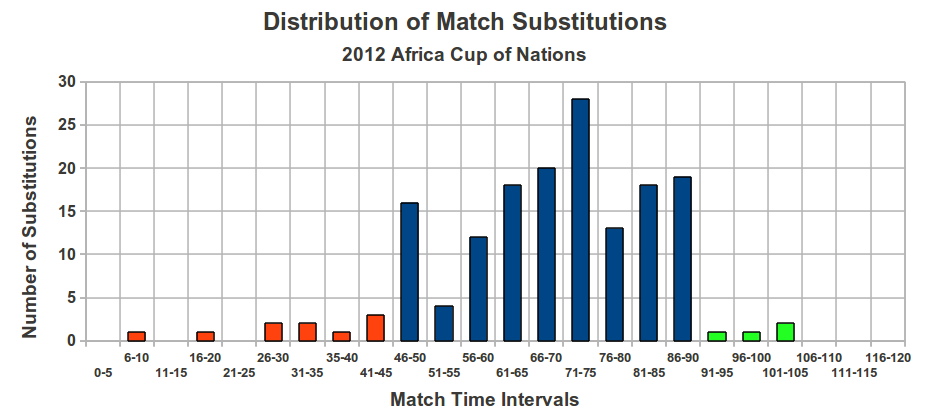Sudden Impact? Substitution at the 2012 Africa Cup of Nations
Categories: Player Performance, Team Performance
How have managers at the Africa Cup of Nations deployed their substitutions during their matches, and have they had their desired impact on the game? I take a look at the match result data to answer the first question and start to answer the second.
One caveat that I should state is that the timings of substitutions have not been fully verified. I have obtained result data from sources such as Goal.com, MTNfootball.com and Football-Lineups.com, and I have been dismayed that the timings of match details have varied to such a degree. (Let’s not even start discussing the huge variation in player names.) I’ve made my feelings about the official CAF AFCON site, but I will use their match event timings as authoritative until convinced otherwise. In the end I think the match times will differ by a minute or two.
Caveat aside, here is the distribution of the substitution events at the AFCON. Time segments are 5 minutes long for a total of 24 segments over the possible length of a soccer match. I do not include stoppage time substitutions, of which there were none in the first half and 10 in the second half (none at the end of the two extra time periods).
There have been 173 substitution events in this year’s Africa Cup of Nations, with one match left to play (average of 5.58 substitutions per game). As you might expect, few substitutions occur in the first half — most tend to be forced by injury, while a majority are driven by an urgent tactical change. There is a big jump in the number of substitutions at the start of the second half, but most subs occur in waves. The first wave starts at around the 60th minute and peaks between the 65th and 75th minutes. The second wave occurs in the final ten minutes as trailing teams attempt to throw as many attacking players as possible or leading teams add defenders and consume time. (That’s my expectation of what’s going on; I have all of the historical data but have not yet processed them so that I know the scorelines at the time of each substitution.) The rate of substitutions crashes during the extra time periods, most likely due to the lack of available subs on either side. Only four subs were made in extra time, and all of them in the first period of extra time.
Now, we have an idea of when managers in the AFCON were more likely to make substitutions. So which subs made the biggest impact of all by scoring a goal?
There were 11 goals scored by substitutes at the AFCON, a little over 15% of the total number of goals (73 total). The table below shows when each substitute entered the match and when he scored. No substitute scored twice in a match.
| Sub Time | Goal Time |
| 28′ | 74′ |
| 46′ | 90′ |
| 46′ | 79′ |
| 46′ | 78′ |
| 55′ | 90+6′ |
| 56′ | 76′ |
| 64′ | 86′ |
| 66′ | 90′ |
| 75′ | 84′ |
| 79′ | 86′ |
| 85′ | 90+7′ |
Of the substitutes who scored goals, three of them were that halftime adjustment by the manager. All but three of the remaining substitute goalscorers entered the match during the first wave of second-half substitutions. One occurred at the half-hour mark, and the other two occurred in the final ten minutes.
I’m struck that all of the goals scored by a substitute occurred in the final fifteen minutes of the match, plus stoppage time. Moreover, they occurred in two bursts: the first around the 75th minute mark, and the second in the final five minutes. All of the substitute goals scored in that first burst were scored by a player who entered by the 56th minute. The earliest that a substitute who entered the match after minute 65 scored a goal was with five minutes of normal time remaining.
So what does it all mean?
One way of looking at these numbers is that the payoff for a substitution, should it occur, happens independently of the player’s entry into the game. But if a team doesn’t want to leave the outcome of the match too late, the opening substitutions need to occur by the hour mark. After that point the chances of a substitute goal drop significantly, at least in this competition.
As I said at the top of this post, I haven’t looked at the scoreline at the time of substitute entry or the impact of their goal on the final outcome of the match. (It would be interesting to compare results with Prof. Bret Myers’ findings that were published last year.) There are also in-match events to consider which my FMRD doesn’t capture — how did the substitute influence the game through his on-field actions, for instance? Nevertheless, this analysis helps to answer a few questions and pose some guiding questions for further analysis.


